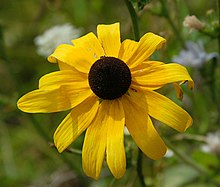Rudbeckia hirta

Rudbeckia hirta, commonly called black-eyed Susan, is a North American flowering plant in the family Asteraceae, native to Eastern and Central North America and naturalized in the Western part of the continent as well as in China. It has now been found in all 10 Canadian Provinces and all 48 of the states in the contiguous United States.[2][3][4]
Rudbeckia hirta is the state flower of Maryland.[5]
Rudbeckia hirta is an upright annual (sometimes biennial or perennial) growing 30–100 cm (12–39 in) tall by 30–45 cm (12–18 in) wide. It has alternate, mostly basal leaves 10–18 cm long, covered by coarse hair, with stout branching stems and daisy-like, composite flower heads appearing in late summer and early autumn. In the species, the flowers are up to 10 cm (4 in) in diameter, with yellow ray florets circling conspicuous brown or black, dome-shaped cone of many small disc florets.[6] However, extensive breeding has produced a range of sizes and colours, including oranges, reds and browns.[3][7]
The specific epithet hirta is Latin for “hairy”, and refers to the trichomes occurring on leaves and stems.[8] Other common names for this plant include: brown-eyed Susan, brown betty, gloriosa daisy, golden Jerusalem, English bull’s eye, poor-land daisy, yellow daisy, and yellow ox-eye daisy.[9]
